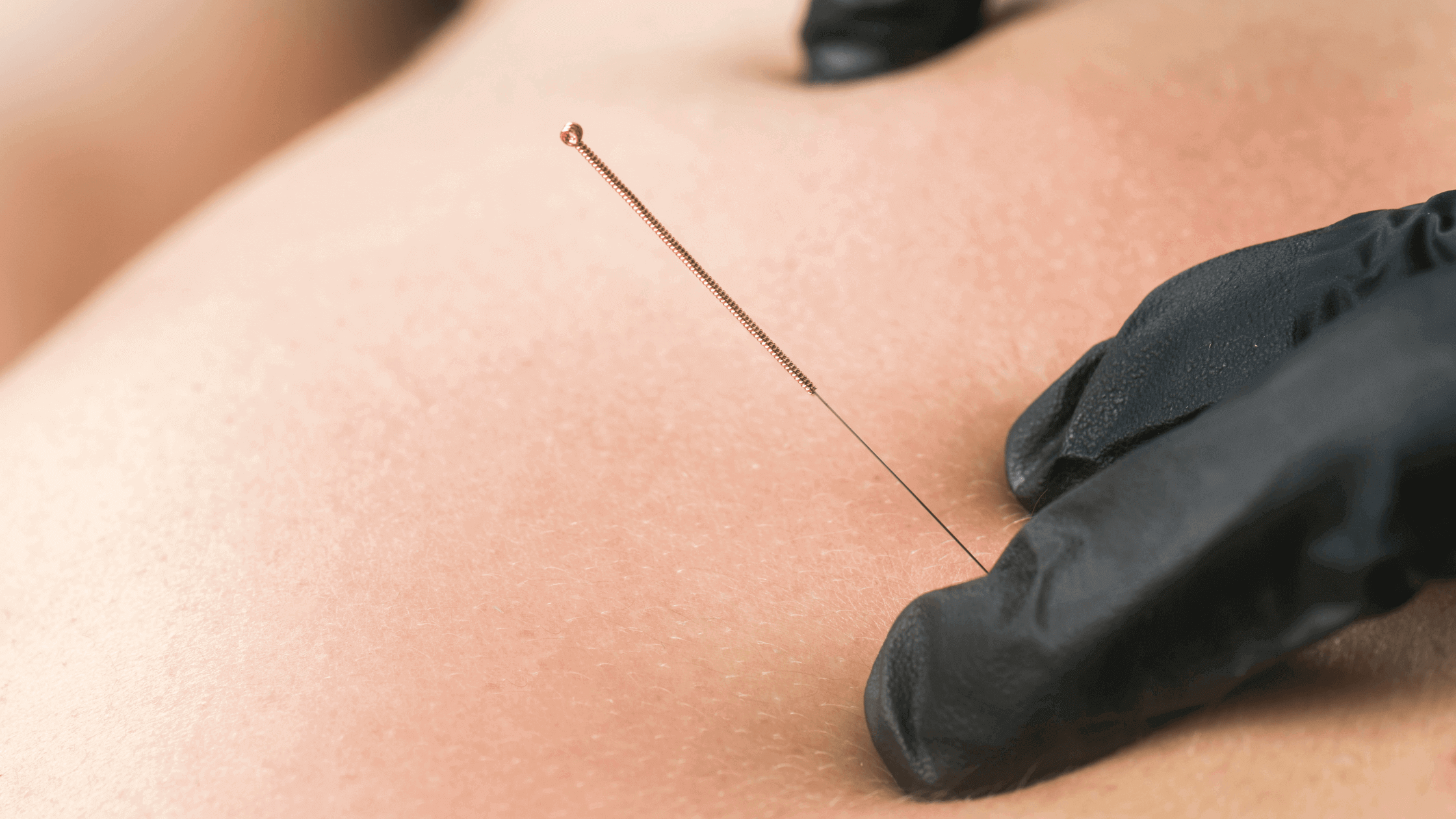Dry needling, also known as trigger point therapy, is a popular treatment technique in orthopedic manual physical therapy. It’s often used to treat myofascial trigger points, which essentially are tight sections of muscle fibers that can form in muscles after they are injured or overused [1]. But what exactly is dry needling, how does it work, and who can benefit from it? Let’s dive in.
WHAT IS DRY NEEDLING?
Dry needling is a technique that involves inserting a thin/fine needle into a trigger point in your muscle. The goal is to release tension, reduce pain, and improve range of motion. Despite the name, the technique is “dry” because no medication or injection is administered [1].
HOW DOES DRY NEEDLING WORK?
From a pain science perspective, trigger points can be obnoxious, constant sources of peripheral nociceptive (pain messages) input leading to peripheral and central sensitization. Dry needling can not only reverse some aspects of central sensitization, it reduces local and referred pain, improves range of motion and muscle activation patterns, and alters the chemical environment of trigger points [1].
In simpler terms, dry needling works by stimulating the trigger point, which can help to reset the muscle and alleviate pain and discomfort. The needle causes a small disruption in the tissue, which the body responds to by increasing blood flow and releasing biochemical substances that help heal the area [3].
WHO BENEFITS FROM DRY NEEDLING?

Dry needling can be beneficial for a wide range of individuals, particularly those dealing with chronic pain or muscle tension. It’s commonly used in the treatment of musculoskeletal conditions, such as shoulder impingement, rotator cuff tendon pain, tennis elbow, carpal tunnel syndrome, headaches, knee pain, shin splints, plantar fasciitis, or low-back pain [1].
Athletes and active adults can particularly benefit from dry needling. For instance, a case study on proximal hamstring tendinopathy, a relatively uncommon overuse injury seen in runners, showed that dry needling, in combination with eccentric loading of the hamstrings and lumbopelvic stabilization exercises, provided short- and long-term pain reduction and functional benefits [4].
IS DRY NEEDLING SAFE?
Dry needling is generally considered safe. A survey of licensed Physical Therapists reported very common mild adverse events such as bruising, bleeding, and pain during or after treatment. However, no significant adverse events occurred, suggesting that for the PT’s surveyed, dry needling appeared to be a safe treatment [2].
THE IMPORTANCE OF EXERCISE AND MOVEMENT IN PAIN TREATMENT
While dry needling can be an effective treatment for certain types of pain, it is important to understand that it is not a standalone solution. 100% of the time, we recommend that it should be incorporated into a comprehensive treatment plan that includes strength exercise and other movement.
Exercise, particularly strength training, plays a crucial role in managing and reducing pain. It helps to improve muscle strength, flexibility, and overall function, which can alleviate stress on the joints and reduce pain. Exercise stimulates the release of endorphins, the body’s natural painkillers, which can help to further alleviate pain and improve mood [5].
In addition to strength training, incorporating movement into your daily routine is also essential. Regular movement helps to keep the joints flexible, improve circulation, and promote healing. It also helps to prevent stiffness and muscle atrophy, which can contribute to chronic pain [6].
DRY NEEDLING AS PART OF A COMPREHENSIVE TREATMENT PLAN
Dry needling can be a valuable addition to a comprehensive treatment plan for pain. However, it is not a cure-all solution. It is most effective when used in conjunction with other treatments, such as manual therapy and therapeutic exercise [7].
A study published in the Journal of Clinical Medicine found that patients with mechanical neck pain who received dry needling in addition to manual therapy and exercise experienced greater improvements in pain and disability compared to those who received only manual therapy and exercise [8]. However, the study also emphasized the importance of a multimodal treatment approach, noting that dry needling alone may not be sufficient to fully address the complex nature of chronic pain.
In conclusion, while dry needling can be a beneficial treatment for certain types of pain, it is most effective when used as part of a comprehensive treatment plan that includes strength exercise and movement. As always, it is important to consult with a healthcare professional to determine the best treatment plan for your specific needs.
CONCLUSION
Dry needling is a promising treatment for managing pain and improving muscle function, particularly for active adults and athletes. As with any treatment, it’s important to seek care from a trained professional to ensure the procedure is done safely and effectively. If you’re searching for “dry needling near me,” consider reaching out to our physical therapy practice for more information.
SOURCES
[1]: Dommerholt, J. (2011). Dry needling — peripheral and central considerations. [Journal of Manual & Manipulative Therapy](https://dx.doi.org/10.1179/106698111X13129729552065)
[2]: Brady, S., McEvoy, J., Dommerholt, J., & Doody, C. (2014). Adverse events following trigger point dry needling: a prospective survey of chartered physiotherapists. [Journal of Manual & Manipulative Therapy](https://dx.doi.org/10.1179/2042618613Y.0000000044)
[3]: Hsieh, Y., Yang, S., Yang, C., & Chou, L. (2012). Dry Needling at Myofascial Trigger Spots of Rabbit Skeletal Muscles Modulates the Biochemicals Associated with Pain, Inflammation, and Hypoxia. [Evidence-Based Complementary and Alternative Medicine](https://dx.doi.org/10.1155/2012/342165)
[4]: Jayaseelan, D. J., Moats, N., & Ricardo, C. R. (2014). Rehabilitation of proximal hamstring tendinopathy utilizing eccentric training, lumbopelvic stabilization, and trigger point dry needling: 2 case reports. [Journal of Orthopaedic & Sports Physical Therapy](https://dx.doi.org/10.2519/jospt.2014.4905)
[5]: Aydın, T., Dernek, B., Şentürk Ege, T., Karan, A., & Aksoy, C. (2018). The Effectiveness of Dry Needling and Exercise Therapy in Patients with Dizziness Caused By Cervical Myofascial Pain Syndrome; Prospective Randomized Clinical Study. [Pain Medicine](https://dx.doi.org/10.1093/pm/pny072)
[6]: Tejera-Falcón, E., Toledo-Martel, N. del C., Sosa-Medina, F. M., Santana-González, F., Quintana-de la Fe, M. del P., Gallego-Izquierdo, T., & Pecos-Martín, D. (2017). Dry needling in a manual physiotherapy and therapeutic exercise protocol for patients with chronic mechanical shoulder pain of unspecific origin: a protocol for a randomized control trial. [BMC Musculoskeletal Disorders](https://dx.doi.org/10.1186/s12891-017-1746-3)
[7]: Garcia-de-Miguel, S., Pecos-Martín, D., Larroca-Sanz, T., Sanz-de-Vicente, B., Garcia-Montes, L., Fernández-Matías, R., & Gallego-Izquierdo, T. (2020). Short-Term Effects of PENS versus Dry Needling in Subjects with Unilateral Mechanical Neck Pain and Active Myofascial Trigger Points in Levator Scapulae Muscle: A Randomized Controlled Trial. [Journal of Clinical Medicine](https://dx.doi.org/10.3390/jcm9061665)
[8]: Gattie, E., Cleland, J., Pandya, J., & Snodgrass, S. (2021). Dry Needling Adds No Benefit to the Treatment of Neck Pain: A Sham-Controlled Randomized Clinical Trial With 1-Year Follow-up. [Journal of Orthopaedic & Sports Physical Therapy](https://dx.doi.org/10.2519/jospt.2021.9864)


